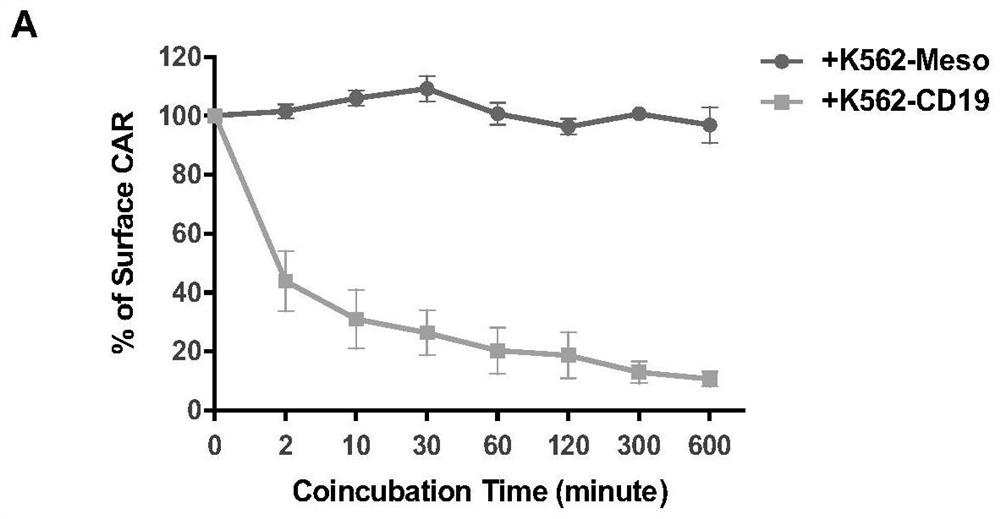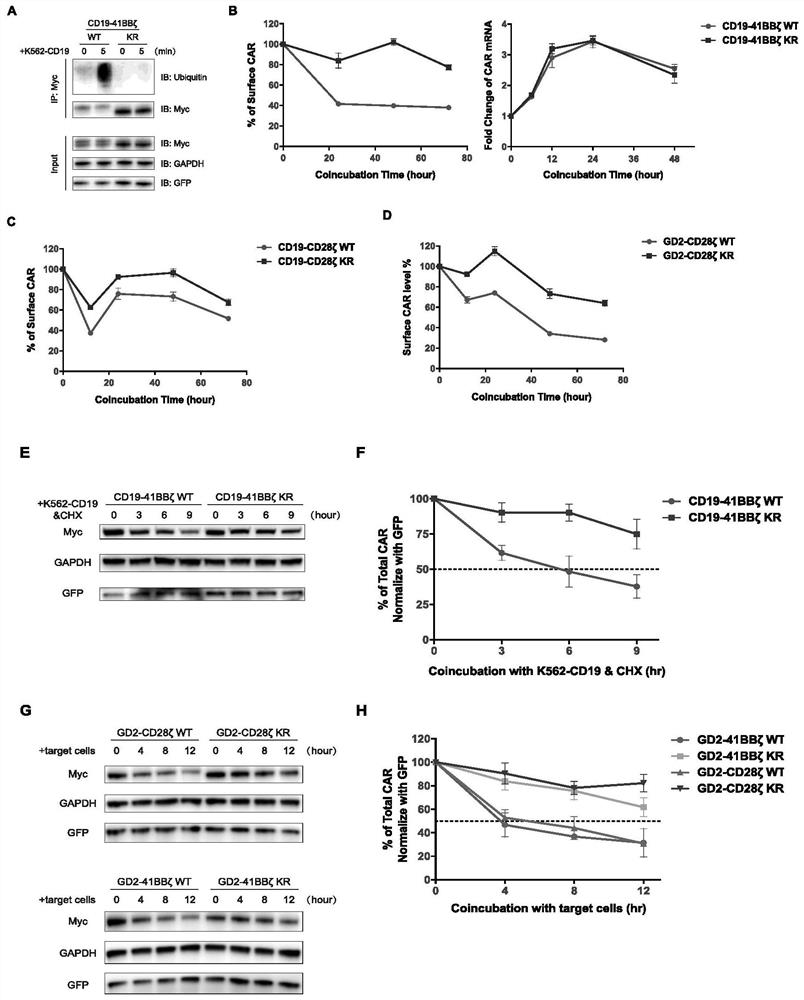Chimeric antigen receptor lack of ubiquitination and application of chimeric antigen receptor
A chimeric antigen receptor and antigen recognition technology, which is applied to cancer antigen components, vertebrate antigen components, medical preparations containing active ingredients, etc., can solve the problem of limited scale industrial production and clinical practice, low transformation efficiency, Problems such as difficulty in construction
- Summary
- Abstract
- Description
- Claims
- Application Information
AI Technical Summary
Problems solved by technology
Method used
Image
Examples
Embodiment 1
[0129] Embodiment 1: Vector construction of CAR
[0130] The antigen-specific single-chain antibody (scFv) sequences of CD19 and GD2CAR used in the present invention are respectively derived from clinically used FMC63 and 14g2a sequences. The extracellular segment structure of CAR is composed of CD8α signal peptide sequence, myc tag sequence, scFv sequence, and CD8α hinge sequence in series; the transmembrane sequence is the transmembrane sequence of CD8α; Or CD28 intracellular segment sequence in series with human CD3ζ intracellular segment sequence. The above amino acid sequence and the amino acid sequence in which lysine is mutated into arginine in the intracellular segment are converted into base sequences after codon optimization and synthesized by the company (Qinglan Biotech). The base sequences of all CARs in the present invention are finally cloned into the pHR-hEF1α-IRES-EGFP vector by means of Gibson connection (NEB#E2611L), and the part of the CAR used in the fluo...
Embodiment 2
[0131] Example 2: Human primary T cell culture and lentivirus infection
[0132] Human primary T cells were obtained from healthy informed volunteers. Primary T cells were cultured in RPMI-1640 medium containing 10% fetal bovine serum, 100 U / ml penicillin and 100 μg / ml streptomycin sulfate (the above reagents were all purchased from Gibco). In order to maintain the proliferation of T cells, 100 U / ml of hIL-2 (Sigma-Aldrich) was added to the culture medium.
[0133] Preparation of lentivirus: 2.2×10 5 Lenti-X 293T cells (TaKaRa #632180) were resuspended in DMEM medium (Gibco #11995-065) containing 10% fetal calf serum and cultured in 6-well cell culture plates (Corning #CLS3516) for 24 hours. Using the liposome transfection system (Mirus#2300), transfect 500ng lentiviral packaging plasmids pCMVdR8.92 (Addgene#8455) and pMD2.G (Addgene#12259) with 500ng lentiviral plasmids to be packaged according to liposome transfection The operating steps of the manual are added to the Len...
Embodiment 3
[0135] Example 3: Flow Cytometry Analysis
[0136] For staining of cell surface markers: antibodies were diluted in FACS buffer (phosphate buffered PBS+2% fetal bovine serum) and incubated with cells for 25 minutes at 4°C in the dark.
[0137] For staining containing intracellular markers: cells were first fixed with 4% paraformaldehyde (Meilunbio #MA0192) at room temperature for 15 minutes, and then permeabilized using pre-cooled methanol on ice for 50 minutes. Staining was then performed by co-incubating with antibody dilutions (same as surface staining) for 60 minutes in the dark at room temperature. The Zombie Violet Fixableviability Kit (Biolegend #423114) was used to distinguish between live and dead cells.
[0138] Flow cytometry data were acquired by a BD LSR Fortessa machine (BD bioscience) and data analysis was performed using FlowJo software (Tree Star). Antibodies used in flow cytometry are listed below.
[0139]
[0140]
PUM
 Login to View More
Login to View More Abstract
Description
Claims
Application Information
 Login to View More
Login to View More - R&D
- Intellectual Property
- Life Sciences
- Materials
- Tech Scout
- Unparalleled Data Quality
- Higher Quality Content
- 60% Fewer Hallucinations
Browse by: Latest US Patents, China's latest patents, Technical Efficacy Thesaurus, Application Domain, Technology Topic, Popular Technical Reports.
© 2025 PatSnap. All rights reserved.Legal|Privacy policy|Modern Slavery Act Transparency Statement|Sitemap|About US| Contact US: help@patsnap.com



